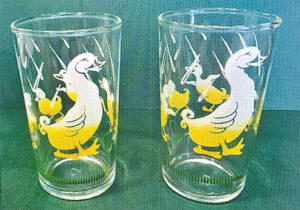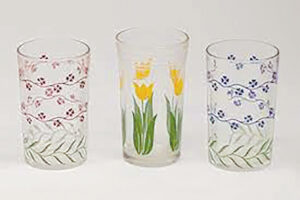 By Carol J. Perry
By Carol J. Perry All over the United States today colorful dinosaurs scamper across kitchen tumblers which used to hold grape jelly. Beverages are often poured from pitchers or decanters which may have originally contained maple syrup, vegetable oil or instant coffee. Recycling-conscious Americans have become accustomed to the thrifty convenience of reusable glass containers.
But it was only 89 years ago, in October of 1933, that Kraft Foods first introduced this pleasant feature to a receptive public. Kraft called their innovative jolly little glass containers “Swankyswigs,” and they used them for packaging cheese spreads. Before the advent of these trim, straight-sided tumblers, glass food containers were clunky, thick-sided affairs with fat, bulky rims. It was Kraft’s Vice President in charge of Advertising and Public Relations, John H. Platt, who thought up the idea.
He began a search for a company which could develop a cap to safely seal the product without marring the glass. The White Cap Company came up with the answer, a sealing cap with an attached natural rubber gasket. Decorations were Platt’s next priority, and the Hazel Atlas Company won the assignment to provide a color decoration for the new “juice glasses.” Their first design was a hand-applied red horizontal band 1/8-inch wide, with a hairline-width black stripe.
 Kraft made five different varieties of cheese spreads at that time, and when the newly-colorful packages showed up on the nation’s grocery shelves in the fall of 1933, they were an immediate hit. In fact, Kraft’s cheese spreads sales jumped an incredible 601% that first year! By then the Hazel Atlas’ Wheeling, West Virginia plant was operating around the clock, keeping 280 women busy applying the hand-painted designs, which had been updated to alternating stripes of black and red, two each. These glasses were so tremendously popular that they’re still showing up at flea markets and garage sales with surprising frequency—more often than many of the later patterns, as a matter of fact. Both of these early striped glasses are just a hair over 3-1/4″ tall and have vertical 1/4″ paneled ridges on the inside.
Kraft made five different varieties of cheese spreads at that time, and when the newly-colorful packages showed up on the nation’s grocery shelves in the fall of 1933, they were an immediate hit. In fact, Kraft’s cheese spreads sales jumped an incredible 601% that first year! By then the Hazel Atlas’ Wheeling, West Virginia plant was operating around the clock, keeping 280 women busy applying the hand-painted designs, which had been updated to alternating stripes of black and red, two each. These glasses were so tremendously popular that they’re still showing up at flea markets and garage sales with surprising frequency—more often than many of the later patterns, as a matter of fact. Both of these early striped glasses are just a hair over 3-1/4″ tall and have vertical 1/4″ paneled ridges on the inside. Kraft’s third design had a fairly short life. A little taller than the first two, 3-3/8″, it featured two blue bands with two white hairlines. It’s a rarity today.
Kraft’s next design still required handwork, but a new squeegee technique using silk stencils made the decorating process a little more sophisticated. Consumers liked the all-over random dot-within-a-circle pattern rendered in red, green and black. The dot pattern glasses were 3-1/2″ tall, as were the next ones presented to the cheese spread-buying public, an all-over star pattern in the same colors, offered in 1935.
Meanwhile, back at the glass plant, Hazel Atlas designers were scrambling around trying to produce better, more uniform silk screen stencils. They came up with a cheery, neat, red-and-white checkerboard pattern. A daintier checked pattern followed. Both of these prim and pretty designs are rarities now. At about the same time, Atlas produced a trim, all-blue sailboat design, complete with waves and seagulls. This is another hard-to-find Swankyswig, although it occasionally turns up among Depression glass items mistakenly identified as part of a similarly-patterned cocktail set.
1937 saw the birth of Kraft’s most famous cheese glass pattern ever—the tulip. The familiar 3-1/2″ straight-sided glass was used, and stylized tulips bloomed in neat pots of red, green, blue and black. White leaves and stems provided contrast. The tulip glasses quickly eclipsed all the other designs in popularity and to this day are a favorite with collectors. The same design in the same colors was used again later on a 3-1/2″ glass with a slightly flared top impressed with six horizontal rings. This was soon followed by a taller version, flared gracefully at the top with four rings of graduating widths. The black tulip design was replaced with an eye-catching pale blue, and the pot was deleted. Leaves and stems were green instead of white.
The last of the Kraft tulip patterns was offered in 1940 as one of a group of new designs dubbed “posy patterns.” The brightly-colored straight-sided glasses stood 3-1/2″ tall, and sprightly tulips were red with large, curving green leaves.
From time to time, over the years, Kraft introduced new varieties in their cheese spread line, but no attempt was ever made to put any one flavor into a specific container. A red tulip glass might contain pineapple, pimento, or any other of Kraft’s spreads. The identification was always specified on the wash-off paper label. But the Kraft folks were sensitive to consumer preference and kept careful tabs on which of their innovative designs sold best. Oddly enough, Carnival glass, which had emerged as the darling of the American housewife, was not popular at all as a cheese tumbler. A trial run in 1939 consisted of four colors: blue, red, green and yellow. Grocers and shoppers alike turned thumbs-down on the product-obscuring, gaudy opaque glass.
Kraft’s colorful glasses fell victim to strict World War II government regulations, so consumers had to make do with plain clear containers until 1946 when Swankyswigs next emerged—again in the familiar “posy” patterns. In addition to the red tulip design there were pale-blue cornflowers, bright-yellow jonquils and deep-blue violets, all with green leaves. A modern-looking flower with spikey petals was introduced in 1947 in the familiar red, yellow, light-blue and dark-blue spectrum. This was followed in 1948 by a design featuring horizontal bands of forget-me-nots in the same four colors.
Kraft was honored in 1949 when Swankyswigs were nominated to Packaging’s Hall of Fame. The colorful little containers were recognized as the world’s most popular re-use package. They were also honored for making advances toward perfecting multicolor ceramic labeling on glass.
It wasn’t until the early ’50s that the bottom of the glasses were tapered inward to make stacking easier. At about the same time, a new “posy” appeared, a band of green leaves topped by one band each of red and white blossoms. In 1954 this same stackable 3-3/4″ glass was used again: early American silhouettes showed spinning wheels, teapots, trivets and the like in red, black, green and blue. This theme was a successful one, and Kraft quickly followed up with another historical motif. This time an old-fashioned family was depicted in shades of red, green, blue, orange and a new rich-brown color. On each glass family members are occupied in various homey pursuits—viewing a stereoscope, having tea, chatting on an old-time telephone.
The last of the Swankyswig series appeared in the late ’50s and delighted millions of American children. Cute baby animals cavort around the glasses. Bunnies, ducks, squirrels, pigs, bears, puppies, roosters and elephants are cleverly rendered in brown, black, green, blue, orange and red. Each design is topped with a border of miniature “toy” animals of the same species.
The last three mentioned designs are still the easiest for collectors to find, and it’s possible with judicious searching of antiques shops, flea markets and church bazaars to collect complete sets without spending a fortune. The airy, modern flower of the 1948 series is still around in considerable numbers, too. But like all the other “new” collectibles, Swankyswigs are going fast. Be prepared to pay more for the more common patterns in a shop or at a show. The rarer ones are proportionately more expensive. But keep your eyes open for bargains at yard sales and flea markets, and don’t forget to peek into Mom’s or Grandma’s cupboard. Your very own childhood Swankyswig juice glass may still be there!















Follow Us